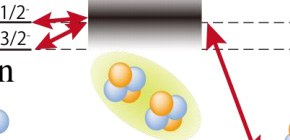
A hypothesis of big-bang nucleosynthesis denied
Mystery of big-bang nucleosynthesis further deepens
A group of researchers led by Associate Professor KAWABATA Takahiro at the Graduate School of Science, Kyoto University, Senior Visiting Scientist KUBONO Shigeru at the Nishina Center, RIKEN, and Associate Professor IWASA Naohito at the Graduate School of Science, Tohoku University, succeeded in measuring the cross section for the 7 Be+n→ 4 He+ 4 He reaction, which is caused by big-bang nucleosynthesis by using facilities at the Research Center for Nuclear Physics, Osaka University. The nuclear cross section is used to express the probability of scattering or reaction caused by interaction between quantum mechanical particles.
The Big Bang Theory describes that, from 10 seconds after to 20 minutes after the beginning of the universe, big-bang nucleosynthesis (BBN) took place and produced light elements such as hydrogen, helium, and lithium. For isotopes of hydrogen and helium, their predicted values with the observations correspond to theoretically predicted values, while for lithium, their predicted values with the observations are one third of theoretically predicted values. This inconsistency draws attention as a “cosmological lithium problem.” As one of the hypotheses to solve this problem, the possibility that the 7 Be+n→ 4 He+ 4 He reaction occurs at a high rate was pointed out; however, it was difficult to perform experiments in the energy region related to BBN and cross sections have not been measured.
To solve this problem, this group came up with a method for measuring the cross section for the 4 He+ 4 He→ 7 Be+n reaction, which is the time-reverse reaction of the 7 Be+n→ 4 He+ 4 He reaction. By irradiating 4 He 2+ beams on He gas and measuring emitted neutrons, this group confirmed that the ground and first excitation states of 7 Be were produced, determining the cross sections. From this, on the basis of the detailed balance principle, which is led from time-reversal invariance of nuclear reaction, this group succeeded in determining the cross sections for the Be+n→ 4 He+ 4 He reaction.
It was clarified that the cross sections for the Be+n→4He+4He reaction were 10 times smaller than the theoretical estimation widely used in the BBN calculations and that the Be+n→4He+4He reaction was not large enough to solve the cosmological lithium problem, deepening the mystery of BBN. The promising solution for BBN was denied in this study, which will encourage researchers to review the nuclear reaction rate and explore new physics beyond the Standard Model of Big Bang cosmology toward the solution of the cosmological lithium problem.
Abstract
The cross sections of the 7 Be ( n , α ) 4 He reaction for p -wave neutrons were experimentally determined at E c . m . = 0.20 – 0.81 MeV slightly above the big bang nucleosynthesis (BBN) energy window for the first time on the basis of the detailed balance principle by measuring the time-reverse reaction. The obtained cross sections are much larger than the cross sections for s -wave neutrons inferred from the recent measurement at the n_TOF facility in CERN, but significantly smaller than the theoretical estimation widely used in the BBN calculations. The present results suggest the 7 Be ( n , α ) 4 He reaction rate is not large enough to solve the cosmological lithium problem, and this conclusion agrees with the recent result from the direct measurement of the s -wave cross sections using a low-energy neutron beam and the evaluated nuclear data library ENDF/B-VII.1.
Figure 1
To learn more about this research, please view the full research report entitled “ Time-reversal measurement of the p-wave cross sections of the 7 Be(n,α)4He reaction for the cosmological Li problem ” at this page of the Physical Review Letters website.
Related link
